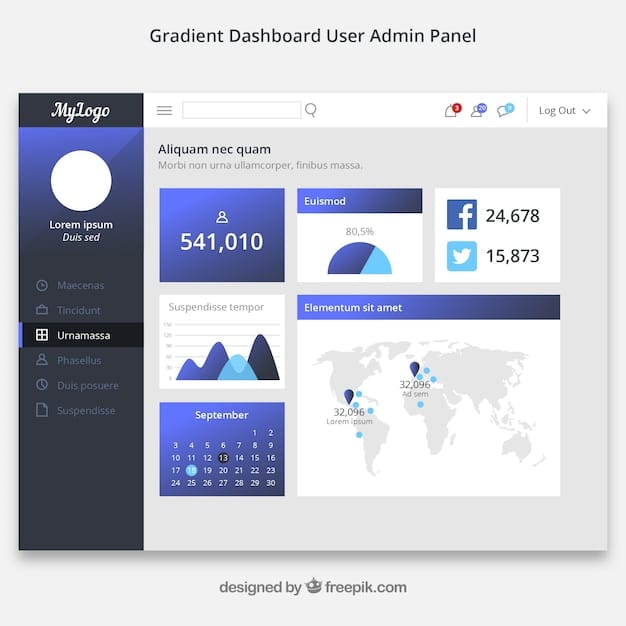Facebook Ad Policy: Avoid Violations & Maximize US ROI

Navigating Meta’s evolving ad policies is crucial for U.S. businesses to avoid violations, ensure campaign continuity, and ultimately maximize their return on investment by reaching target audiences effectively and compliantly.
For businesses across the United States, mastering Facebook’s updated ad policies: avoiding violations and maximizing ROI for US businesses is no longer just good practice—it’s a fundamental requirement for sustained digital growth. Understanding these dynamic guidelines ensures your ad campaigns not only reach their intended audience but also remain compliant, safeguarding your investment and reputation.
Understanding the Evolution of Facebook Ad Policies
Facebook, or more broadly Meta, continuously refines its advertising policies to create a safer and more transparent environment for its users. These updates are often a response to evolving regulatory landscapes, user feedback, and the need to combat misinformation and harmful content. For U.S. businesses, a clear grasp of these changes is paramount, as non-compliance can lead to severe consequences, including ad account restrictions or permanent bans. The proactive adoption of these guidelines is essential for business continuity and effective market reach.
The policy evolution reflects a broader commitment to responsible advertising. Early iterations of Facebook’s ad policies were relatively straightforward, focusing primarily on obvious violations like illicit content. However, as the platform grew in influence and complexity, so did its regulatory framework. Today’s policies are intricate, delving into areas such as data privacy, political advertising, health claims, and even the nuances of landing page content.
Key Drivers Behind Policy Changes
Several factors consistently drive Meta’s ad policy updates:
- Regulatory Compliance: Adapting to new laws like the CCPA or FTC guidelines, particularly in the U.S.
- User Trust and Experience: Ensuring ads are relevant, truthful, and do not mislead or annoy users.
- Combating Misinformation: Strict rules around false claims, especially concerning health, elections, or public safety.
- Brand Safety: Protecting advertisers’ brands from being associated with inappropriate content.
The implications for U.S. businesses are profound. From small local shops to large enterprises, every advertiser must treat these policies not as mere suggestions but as strict operational mandates. Ignoring them can mean not just lost advertising spend, but a significant disruption to marketing efforts and potential reputational damage. Continuous education and adaptation are key to navigating this dynamic landscape successfully.
Moreover, the enforcement mechanisms have become increasingly sophisticated. Meta employs a combination of AI-driven systems and human review to identify and address policy violations. This means that advertisers cannot rely on slipping through the cracks; consistent vigilance and adherence are the only viable strategies. Staying informed about these policy shifts is foundational for any business leveraging Meta’s powerful advertising ecosystem.
Common Policy Violations and How to Avoid Them
Even seasoned marketers can inadvertently run afoul of Facebook’s ad policies. Understanding the most frequent violations is the first step toward effective prevention. These often stem from misinterpretations of the rules or a lack of awareness regarding specific prohibited content and practices. For businesses operating within the U.S., these pitfalls can be particularly tricky, given the nuanced regulatory environment around consumer protection, health, and finance. Avoiding these common errors is critical for maintaining an active and effective presence on the platform.
One prevalent issue involves “Prohibited Content.” This category is broad, encompassing everything from illegal products or services to discriminatory practices. Advertisers must be extremely careful with their ad copy and creative elements to ensure they do not imply or promote any form of discrimination based on race, ethnicity, national origin, religion, sexual orientation, disability, or medical condition. For housing, employment, and credit ads, Meta has specific “Special Ad Categories” that require unique targeting limitations to prevent discriminatory practices. Adhering to these strict guidelines is paramount.
Specific Areas of Concern and Solutions
- Misleading Claims: Avoid exaggerated or unsubstantiated claims, especially regarding health products, financial opportunities, or rapid results. Back up any strong claims with clear evidence and accurate language.
- Personal Attributes: Do not imply knowledge of a user’s personal characteristics, such as their financial status, health condition, or sexual orientation. Phrases like “Are you struggling with debt?” or “Do you have diabetes?” are often flagged. Focus on the product or service itself, not the user’s perceived state.
- Restricted Content: Items like alcohol, dating services, real money gambling, and pharmaceuticals have strict age and geographical targeting requirements. Even if legally permitted in the U.S., specific state and local laws may apply, and Meta’s policies go beyond legal compliance to include responsible advertising.
- Low Quality or Disruptive Content: Ads that use excessive text, poor image quality, or deceptive calls to action (e.g., fake “play” buttons on images) are often rejected. Ensure your creatives are professionally designed and user-friendly.
Another area of frequent violation is “Data Privacy and Usage.” Meta has stringent rules about how advertisers can collect and use user data. This includes prohibiting the scraping of user data, requiring proper consent for data collection, and ensuring that landing pages respect user privacy. Any ad that links to a non-secure site (not HTTPS) or a site with a dysfunctional privacy policy can trigger a violation. Regularly auditing your landing pages for compliance is a necessary step.
Finally, “Circumventing Systems” is a serious violation that results in immediate ad account disablement. This includes creating new ad accounts to bypass previous restrictions, cloaking (showing different content to Facebook’s reviewers than to users), or using deceptive tactics to hide policy-violating content. Transparency and integrity are key. Businesses must operate with the understanding that Meta’s systems are designed to detect such evasive behaviors, and attempts to circumvent will inevitably lead to severe consequences. Proactive adherence and continuous monitoring of both ad creatives and associated landing pages are essential strategies for staying compliant and ensuring campaign longevity.
Navigating Special Ad Categories for U.S. Businesses
For U.S. businesses, certain advertising topics fall under what Facebook terms “Special Ad Categories.” These categories—housing, employment, and credit opportunities—are subject to stricter rules not just because of Meta’s general policies, but largely due to federal laws like the Fair Housing Act, the Equal Credit Opportunity Act, and various anti-discrimination statutes. Understanding and correctly applying these rules is non-negotiable for any advertiser in these sectors to avoid legal repercussions and platform violations.
The primary restriction within Special Ad Categories is related to targeting options. Advertisers cannot use attributes that directly or indirectly relate to protected characteristics. This means no targeting based on age, gender, race, religion, sexual orientation, disability, or zip code, among others, even if such targeting is generally available for other ad types. Instead, Meta automatically applies broad audience categories and removes specific demographic targeting options when an ad is declared as a “Special Ad Category.” This automated restriction is a critical safeguard against discrimination.
Compliance Requirements for Special Ad Categories
- Declare Your Ad: The most fundamental step is to correctly declare your ad as belonging to a Special Ad Category during the campaign setup process. Failure to do so will result in an ad rejection and potential account flags.
- Avoid Discriminatory Language: Beyond targeting, the ad creative itself must be free of any language that suggests preference for or discrimination against any protected group. This applies to images, videos, and ad copy.
- Broader Targeting: Embrace the broader targeting requirements. While it might seem counterintuitive to marketing precision, this is a legal and ethical requirement. Focus on interests and behaviors that are not linked to protected classes.
- Educational Content: For housing, employment, and credit, consider creating educational content that subtly reaches your audience without discriminatory targeting.
The rationale behind these stringent rules is to prevent algorithmic bias and to ensure equitable access to opportunities for all individuals, regardless of their background. For example, a housing ad cannot target individuals based solely on income proxies derived from their online behavior, nor can it exclude certain zip codes that might correlate with a specific demographic. The goal is open access for all eligible individuals.

Furthermore, these policies affect ad objectives. While general brand awareness campaigns might seem less restrictive, any ad that promotes, offers, or facilitates housing, employment, or credit opportunities will fall under these rules. This means that even a simple “now leasing” ad for apartments must adhere to these special ad category regulations if it is placed in the U.S. Market. Businesses must internalize these rules as a non-negotiable part of their advertising strategy within these sensitive sectors, recognizing that compliance is not just about avoiding penalties but also about adhering to fundamental principles of fairness and equality in advertising.
Failure to comply can result in severe legal ramifications, including lawsuits under federal anti-discrimination laws, in addition to Meta’s penalties. Therefore, continuous training for advertising teams, comprehensive internal reviews of ad creatives, and a deep understanding of what constitutes a “Special Ad Category” are indispensable for any U.S. business operating in these spaces. Proactive compliance not only protects the business but also reinforces its commitment to ethical advertising practices.
Maximizing ROI within Policy Compliance
Adhering to Facebook’s updated ad policies doesn’t mean sacrificing performance; in fact, compliance can significantly enhance your return on investment (ROI). By understanding and working within the guardrails, U.S. businesses can build more sustainable and effective advertising strategies. The key lies in shifting focus from aggressive, potentially rule-bending tactics to creative, compliant, and audience-centric approaches. This strategic pivot ensures long-term success and avoids the costly disruptions associated with policy violations.
One critical aspect of maximizing ROI through compliance is audience understanding. Instead of relying on restricted targeting options, invest more deeply in understanding user behaviors, interests, and pain points that are not linked to protected characteristics. Utilize custom audiences and lookalike audiences based on compliant first-party data, such as website visitors or customer lists. This approach allows for highly effective targeting without venturing into discriminatory practices. The more precisely you understand your compliant audience segments, the more relevant your ads will be, naturally leading to higher engagement and conversion rates.
Strategies for Enhanced Compliant Performance
- High-Quality Creatives: Invest in compelling visuals and ad copy that clearly communicate your value proposition without resorting to clickbait or misleading claims. Authentic, high-quality content naturally resonates better with audiences and reduces scrutiny from Meta’s policy systems.
- Clear Value Proposition: Ensure your ad clearly states what you are offering and who it is for, avoiding ambiguity. This transparency builds trust and reduces the likelihood of users reporting your ad, which can trigger policy reviews.
- Optimize Landing Pages: Your landing page is an extension of your ad. It must be secure (HTTPS), mobile-friendly, fast-loading, and relevant to the ad content. Any discrepancies or poor user experience on the landing page can lead to policy violations, impacting your Quality Score and ultimately your ROI.
- A/B Testing Compliantly: Continuously test different ad creatives, copy, and targeting parameters within policy guidelines. Incremental improvements based on data-driven insights lead to better performance over time.
Furthermore, consistent monitoring of campaign performance in relation to policy adherence is vital. Utilize Facebook’s Ad Manager reporting tools to track not only traditional metrics like CTR and conversions but also relevance scores and feedback from users. High negative feedback (e.g., “I don’t want to see this ad”) can signal policy issues even if a direct violation hasn’t been flagged. Addressing these signals proactively can prevent future problems and optimize ad delivery.
By embracing these strategies, U.S. businesses can transform policy compliance from a compliance burden into a competitive advantage. Ads that are thoughtfully crafted, transparent, and respectful of user privacy and legal guidelines tend to perform better, building trust and fostering stronger relationships with the target audience. Ultimately, this leads to a more sustainable and profitable advertising ecosystem, where ROI is maximized not despite policies, but because of a diligent approach to them.
Best Practices for Ad Account Health and Recovery
Maintaining a healthy ad account on Facebook is as crucial as running effective campaigns. For U.S. businesses, an account in good standing ensures uninterrupted advertising and access to all of Meta’s powerful targeting and optimization tools. Conversely, an unhealthy account, marked by multiple policy violations or repeated rejections, can lead to restrictions, temporary suspensions, or even permanent disablement, directly impacting marketing efforts and the bottom line. Proactive measures are the cornerstone of ad account longevity.
The first best practice involves continuous education and training. Ad policies are dynamic, and what was acceptable last year may not be today. Businesses should establish a routine of reviewing Meta’s official advertising policies, attending webinars, and subscribing to policy updates. Ensure that everyone involved in ad creation and management—from marketers to copywriters and designers—is fully aware of the latest guidelines. This collective knowledge helps prevent inadvertent errors that can accumulate and harm account health.
Key Strategies for Account Health
- Regular Audits: Periodically review all active and paused ad campaigns, as well as their associated landing pages, for policy compliance. Identify and rectify any potential issues before they are flagged.
- Diversify Ad Creatives: Avoid relying on a single ad creative or message that might be borderline compliant. Prepare multiple variations and test them. If one creative faces issues, others can continue running.
- Respond to Notifications: Pay immediate attention to any notifications from Meta regarding ad rejections or policy violations. Address the issue promptly and submit appeals if you believe there was an error.
- Maintain Payment Health: Ensure your payment methods are up-to-date and have sufficient funds. Frequent payment failures can also negatively impact account standing.
- Build a Strong Account History: Consistently run compliant ads that generate positive user feedback. A long history of good behavior builds trust with Meta’s systems.
When an ad account faces restrictions, immediate and systematic recovery steps are essential. First, identify the specific reason for the violation. Meta usually provides a reason, often linking to the exact policy violated. Do not attempt to run the same ad or create a new account without understanding and rectifying the core issue. This is crucial; creating new accounts to bypass a ban is a severe violation that typically leads to permanent exclusion.

If an ad is rejected, edit the ad to comply with the policy and resubmit it. If the entire ad account is restricted, you usually have an option to “Request Review” or “Appeal” the decision through the Account Quality section in your Business Manager. Provide clear, concise explanations and any supporting documentation needed. Patience is key, as these reviews can take time. Demonstrating a clear understanding of the policy and a commitment to complying with it often facilitates a quicker resolution and restoration of account privileges.
Ultimately, a proactive, educational, and responsive approach to ad account management is the most effective way for U.S. businesses to avoid violations and recover swiftly when issues arise. Treating Meta’s policies as an integral part of your advertising strategy, rather than an afterthought, ensures a smoother path to maximizing your advertising ROI.
Future-Proofing Your Facebook Ad Strategy
As the digital advertising landscape continues to evolve at a rapid pace, future-proofing your Facebook ad strategy is imperative for sustained growth and profitability for U.S. businesses. This involves not just reacting to current policy updates, but anticipating future trends and building a resilient, adaptable framework. The shift towards greater privacy, accountability, and user-centric advertising is a permanent fixture, requiring advertisers to adopt a forward-thinking mindset rather than clinging to outdated practices.
One key element of future-proofing is diversified dependency. While Facebook remains a powerful advertising channel, relying solely on one platform poses significant risk. Explore and test other advertising channels (e.g., Google Ads, LinkedIn, TikTok, native advertising) to reduce dependency and mitigate the impact of potential policy changes or account issues on any single platform. This multi-channel approach ensures that your marketing efforts remain robust even if one channel experiences disruption.
Key Pillars for a Future-Proof Strategy
- First-Party Data Emphasis: As third-party cookies diminish and privacy regulations tighten, collecting and leveraging first-party data (data directly from your customers) will become even more critical. Invest in CRM systems, email marketing, and website analytics to build a robust first-party data strategy for compliant targeting and personalization.
- Ethical Advertising Practices: Embrace ethical advertising not just as a compliance measure but as a core brand value. Consumers are increasingly discerning and value transparency and privacy. Ads that genuinely serve user interests and respect their data will build stronger brand loyalty and long-term trust.
- AI and Automation Adoption: Leverage Meta’s own AI-driven optimization tools (e.g., Advantage+ Creative, Advantage+ Shopping Campaigns). These tools are designed to work within current policy frameworks and can adapt more quickly to internal changes within Meta’s algorithms, often outperforming manual optimization in compliant ways.
- Continuous Learning and Adaptation: Foster a culture of continuous learning within your marketing team. The digital landscape will always change. Staying curious, experimenting cautiously, and quickly adapting to new technologies, policies, and consumer behaviors will ensure your strategy remains relevant.
Furthermore, building a strong brand identity and reputation offline can also future-proof your digital efforts. A brand known for its integrity and value proposition will always find it easier to connect with audiences, regardless of platform-specific policies. This foundational trust translates into higher ad effectiveness and resilience against minor policy bumps. Consider investing in brand-building activities that extend beyond direct response advertising.
Finally, engage actively with industry communities and professional networks to stay ahead of the curve. Sharing insights and learning from peers about emerging trends, policy interpretations, and effective strategies can provide invaluable foresight. By combining these proactive strategies—diversification, data emphasis, ethical practices, automation, and continuous learning—U.S. businesses can build a Facebook ad strategy that is not only compliant today but also robust and adaptable enough to thrive in the inevitable digital landscape of tomorrow.
Assessing Impact and Refining Strategies
For U.S. businesses, navigating Facebook’s evolving ad policies is an ongoing process that requires constant assessment and refinement of strategies. Simply implementing compliant campaigns isn’t enough; regular evaluation of their impact is crucial to ensure that advertising efforts remain effective, efficient, and aligned with both business objectives and platform guidelines. This iterative process of review and adjustment is what truly maximizes ROI in a dynamic digital environment.
The first step in assessing impact is to define clear, measurable key performance indicators (KPIs) that go beyond standard metrics. While clicks, impressions, and conversions are important, also consider metrics related to ad quality and feedback. Monitor your ad relevance scores, feedback ratings, and account health notifications within Meta Ads Manager. A decline in ad relevance or an increase in negative feedback can be early warning signs of potential policy issues or audience fatigue, even if a formal violation hasn’t occurred. Proactive self-correction based on these indicators is vital.
Metrics and Adjustments for Strategy Refinement
- Policy Compliance Rate: Track the percentage of your ads that are approved without issues versus those rejected. A high rejection rate signals a systemic problem in understanding or applying policies.
- Ad Performance vs. Compliance: Analyze if your most compliant ads are also your highest-performing. Sometimes, ads that are “too safe” might underperform. The goal is to find the sweet spot where compliance meets strong engagement.
- Audience Feedback Loop: Beyond formal metrics, pay attention to comments on your ads and direct messages. Are users complaining about misleading claims, irrelevant content, or aggressive messaging? This qualitative feedback is gold for refinement.
- Resource Allocation: Assess whether your team spends too much time dealing with policy violations instead of strategic campaign optimization. If so, invest in better training, clearer internal guidelines, or automation tools.
Once data is collected, the refinement process begins. If an ad consistently performs poorly or gets flagged, don’t just resubmit it with minor tweaks. Go back to the drawing board to understand why it failed. Was it the creative? The copy? The targeting? Sometimes, a complete overhaul is necessary. For U.S. businesses, this might involve reviewing the commercial aspects of local consumer protection laws and aligning them with Meta’s guidelines to ensure seamless operation. Refine your ad creatives to be clearer, more transparent, and more user-centric, ensuring they align with Meta’s quality guidelines and brand safety standards.
Furthermore, assess the overall health of your ad account regularly. If warnings or restrictions appear, immediately investigate their root cause. Is it a specific ad violating sensitive content rules? Or a persistent issue with landing page compliance? Addressing these underlying problems systematically prevents recurrence and safeguards your ability to advertise. This holistic view of performance, compliance, and account health allows U.S. businesses to build a robust Facebook advertising strategy that not only avoids violations but consistently drives tangible and maximized ROI over the long term.
Staying Ahead: Tools and Resources for Compliance
Staying compliant with Facebook’s ever-evolving ad policies requires more than just reactive measures; it demands proactive engagement with the tools and resources Meta provides, as well as leveraging external expertise. For U.S. businesses, the sheer volume of information can be overwhelming, but strategic utilization of available resources is key to maintaining a robust and error-free advertising posture. Leveraging these tools helps streamline the compliance process and minimizes the risk of costly violations.
The most important official resource is Meta’s own Ad Policies Help Center. This comprehensive database is regularly updated and contains detailed explanations for every policy category, including specific examples of what is and isn’t allowed. Businesses should bookmark this resource and refer to it frequently. It serves as the definitive guide to understanding the nuances of content, targeting, and behavior policies that apply to all advertisers globally and specifically to the U.S. market.
Essential Tools & Resources for Compliance
- Meta Business Suite and Ads Manager: These dashboards provide real-time updates on ad rejections, policy violations, and account health. The “Account Quality” section within Business Manager is particularly critical for reviewing the status of your ad accounts, business pages, and appealing decisions.
- Meta Policy Guides and Webinars: Meta frequently releases specific guides on complex topics (e.g., political ads, special ad categories) and hosts webinars to explain new policies or best practices. Subscribing to Meta for Business newsletters ensures you receive these timely updates.
- Audience Insights Tool: While not directly a compliance tool, understanding your audience through this tool can help you create more relevant ads that naturally align with user experience policies, reducing the likelihood of negative feedback.
- Landing Page Scanners/Validators: Use external tools or conduct manual checks to ensure your landing pages are secure (HTTPS), functional, mobile-friendly, and that their content aligns perfectly with your ad copy. Discrepancies here are a common cause of ad rejections related to misleading practices or user experience.
- Legal Counsel & Industry Experts: For complex or highly regulated industries (e.g., finance, healthcare, legal services in the U.S.), consider consulting legal professionals specializing in advertising law. Their expertise can help navigate the intersection of Meta’s policies and federal/state regulations.
Furthermore, engaging with Facebook’s support channels can prove beneficial. If you have questions about specific ad content or believe a rejection was in error, reach out to Meta’s advertiser support. While responses can sometimes be slow, persistently seeking clarification can help resolve issues and provide valuable insights into policy interpretations. Document all communication and reasoning for your records.
Finally, a critical but often overlooked practice is to foster an internal culture of compliance awareness. Regular team meetings, internal training sessions, and clear standard operating procedures for ad creation and review can significantly reduce errors. By empowering your marketing team with the knowledge and tools to self-regulate, U.S. businesses can proactively manage risks, ensure continuous operation of their campaigns, and ultimately maximize their advertising ROI without constantly battling policy violations. This holistic approach ensures not just compliance, but sustained competitive advantage.
| Key Point | Brief Description |
|---|---|
| 📚 Policy Evolution | Meta’s ad policies constantly update due to regulations, user trust, and misinformation. Proactive understanding is vital for US businesses. |
| 🚦 Common Violations | Includes misleading claims, personal attributes, restricted content, and low-quality ads. Careful creative and copy are key. |
| ⚖️ Special Ad Categories | Housing, employment, credit ads face strict targeting/language rules due to U.S. anti-discrimination laws. Must declare correctly. |
| 🔮 Future-Proofing | Diversify channels, prioritize first-party data, embrace ethical ads, and utilize AI/automation for long-term ad strategy. |
Frequently Asked Questions
▼
Facebook (Meta) updates ad policies to adapt to evolving regulations, enhance user experience, combat misinformation, and ensure brand safety. These changes reflect a global commitment to responsible advertising and a safer online environment, which directly impacts how U.S. businesses must operate their campaigns.
▼
Common violations include misleading claims, implying knowledge of personal attributes (e.g., “Are you in debt?”), promoting restricted content (e.g., specific health products), and using low-quality or disruptive creatives. Special Ad Categories also pose frequent challenges due to strict anti-discrimination rules.
▼
Maximizing ROI with compliance involves investing in compliant first-party data for targeting, creating high-quality and transparent creatives, optimizing landing pages, and continuously A/B testing within policy guidelines. Ethical advertising practices naturally lead to better engagement and long-term results.
▼
Special Ad Categories for U.S. businesses include housing, employment, and credit opportunities. They require specific declaration and restrict targeting options related to protected characteristics (e.g., age, gender, zip code) to prevent discrimination, adhering to federal fair housing and equal opportunity laws.
▼
If restricted, first identify the specific policy violated. Rectify the issue within your ad or landing page. Then, formally request a review or appeal the decision through your Account Quality dashboard in Business Manager. Avoid creating new accounts, as this can lead to permanent disablement.
Conclusion
For U.S. businesses, navigating Facebook’s updated ad policies is a continuous journey that demands vigilance, adaptation, and an unwavering commitment to ethical advertising. By understanding the rationale behind policy changes, proactively avoiding common violations, embracing the nuances of Special Ad Categories, and leveraging available compliance tools, businesses can transform potential hurdles into strategic advantages. Ultimately, a compliant advertising strategy is not just about avoiding penalties; it’s about building trust, enhancing brand reputation, and securing a sustainable path to maximized advertising ROI in the dynamic digital landscape.





